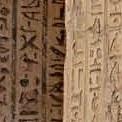Beyond reclaiming the Past: Transmission, reception and revival of texts and iconography in Late Period Egypt
Workshop konzipiert und organisiert vom Projekt A02 "Altägyptische Philologie" (Projektleitung: Prof. Jochem Kahl)
Kontakt: Michaela Engert, michaela.engert[at]fu-berlin.de
The last decade of research on the transmission and reception of texts and iconography in ancient Egypt has revealed that materials from the third and second millennia BCE experienced multiple forms of dissemination and adaptation beyond mechanic copying and active productivity. In 2013, our meeting Überlieferungsformen von Text und Bild im Alten Ägypten – organized under the auspices of SFB 980 at Freie Universität Berlin – aimed to recognize manifestations of these models of transmission from the Old Kingdom to Greco-Roman times and to understand the role of involved actors (priests, scribes artists) and institutions (temples, libraries, workshops). Participant scholars discussed theoretical avenues of transmission, iconographic and literary salient compositions, and the most technical aspects of the reproductive and productive variants of the process. However, the meeting also exposed critical questions to be explored such as the degree of knowledge of the new actors on the ancient works, the boundaries and licenses for creativity, and the rationale behind the adaptation of works with a distinct Zeitgeist to new contexts.
Until now, scholars have exclusively focused on the renascence of old materials in Late Period Egypt as an attempt to reclaim traditional models of society, religion and culture. The use of Pyramid Texts, Coffin Texts and Book of the Dead spells in Late Period tombs certainly implicates a conscious theological search in former texts for particular models of ritual, cult and beliefs, that is the existence of lines of thought being inspired by the past to change their present. The recognition of Old and New Kingdom influences in the decoration of Theban tombs of the Late Period also proves the convergence toward ancient models in Late Period
art. However, the validation of this ancient undertaking has not yet taken us to define the pragmatics of priestly, scribal and artistic commissions in tombs, temples and workshops. Thus, how do we explain the particular procedures of transmission and reception into the Late Period? On the one hand, there are technicalities of the process to be addressed: did the composition of decorative and inscriptional programs depend on manuscript resources (i.e. master books, stock excerpts) from libraries or direct copying from other monuments? Can we discern exercises of reproductive nature from moderate modification or intentional creativity? How do we explain the textual and iconographic selections of each tomb and funerary item? Do they follow any thematic or sequential patterns of organization? Do these patterns coincide with former uses before the Late Period? Do ortographical, lexicographical and grammatical changes evidence the awareness of the texts by the scribal stratum? Did artists allow for genuine authorship, updates and adjustment in the reproduction of ancient iconography? What did Late Period Egyptian artists intend to express by using models from the Pyramid Age or the Eighteenth Dynasty? Although these questions entangle actors with compositions, their expertise with accomplished results, we also aim at exploring the religious and intellectual movements that originated the process: do the new textual and iconography programs respond to changes in the ritual and cultic practices during the Late Period? Can we distinguish predominant aspects of the solar and osirian cults in the materials from these tombs? Is there any evidence from ritual manuscripts or temple inscriptions that might extend the use of textual and iconographic programs beyond the tomb? In which degree does the status of the deceased (priest, official, man-at-arms) inform us about his monument, texts and decoration?
The 2014 workshop will bring together during two days of presentations and discussions ten experts on the architecture, decoration and inscription of Late Period tombs as well as on the major religious and cultural compositions transmitted into this period. The major purpose of this workshop will be to identify the technical and ideological undertakings behind the reception and revival of ancient materials and to determine and understand the social and religious factors that supported this exercise beyond wishing for “living in the past”.
Zeit & Ort
21.11.2014 - 23.11.2014
SFB-Villa, Schwendenerstraße 8, Sitzungsraum, 14195 Berlin-Dahlem
